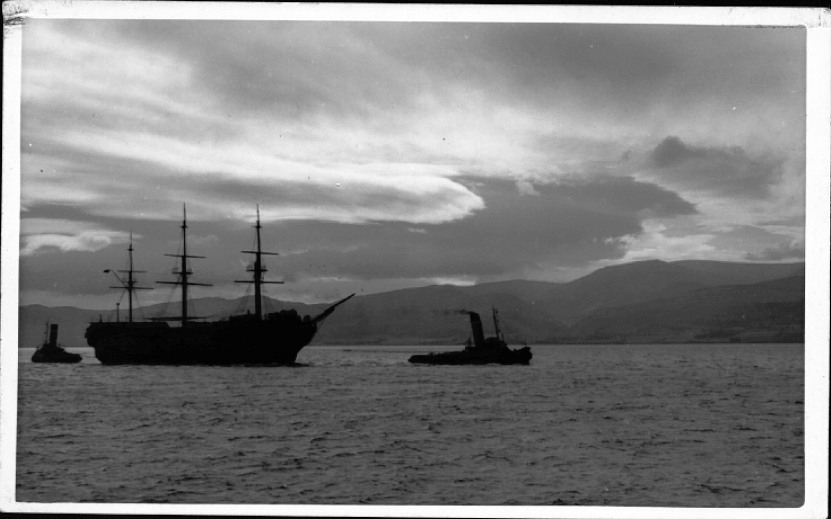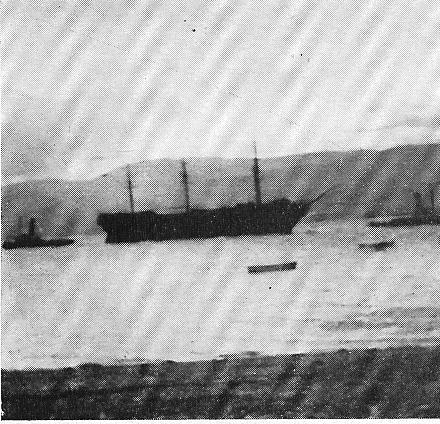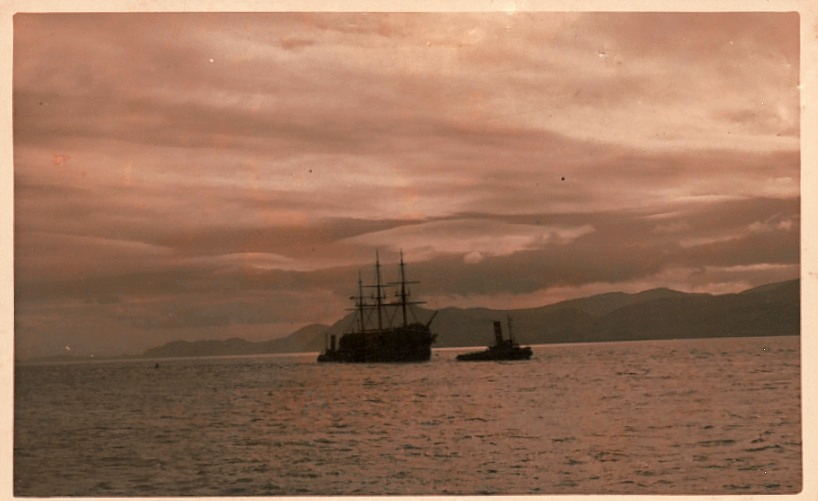|
From Mersey To Menai May
21 - 22 1941
After the Abandon Ship incident, the Conway
Committee decided that training clearly needed to be carried on in more
peaceful surroundings, and decided that the 102 year old wooden wall
should be moved to the Menai Strait in North Wales. It would be her
first sea passage for 65 years.
She was towed by the Rea tugs Langworth
and Dongarth to Glyn Garth Mooring on the Menai Straits, Anglesey, West
of Bangor Pier and close to the Anglesey shore - the mooring is still
marked on charts. She
arrived of Bangor late in the evening.

The son of an Old
Conway recalls: "A bird watching historian friend of my father's
(a few years earlier, obviously) happened to spot the Conway arriving
from Birkenhead, through his telescope from the roof of his student
digs. What a surreal moment that must have been. Remember it
was wartime so there had been no announcement in the papers or on the
radio! The roof he was watching from was that of a house called Plas
Menai in upper Bangor, which (before the block of flats for OAPs was
built about 20 years back) had a nice view of the Straits over Siliwen."
Article in the Cadet October 1959
(Centenary Edition) by Captain T Goddard RNR
"It was decided to send the ship to the
Menai Straits where there was an anchorage off Bangor which would suit
us. It was well into May 19 41 that the moorings could be laid by the
Trinity House Ship Beacon, and tugs were available. We slipped our moorings
at 1500 and 24 hours later were secured to our new ones off Bangor.
Entering Crosby Channel the stern tug was let go and made fast forward
so the two tugs towed the ship at 3 to 4 knots. The tow to the Bar Light
Vessel, 17 miles from the Sloyne, took nine hours - nearly seven of
which were against the flood tide so that we could better keep her under
control.
We averaged seven knots over the ground
from the Bar Light Vessel to Puffin Island, where we stopped until nearly
High water when we negotiated the channel. This was uneventful but the
S bend in it between No 1 buoy and Beaumaris required quick alterations
in course with only two feet of water under our bottom. On sighting
Conway as she rounded Gallows Point, my daughter Rosemary, who was acting
as my Secretary, sent telegrams to all Cadets to rejoin the ship. To
make up for lost time the Summer term was extended well into August,
so that during the whole of the war not a day was lost to the Cadets."

Article in the Cadet October 1941
by JS Fairweather
"We had been waiting day after day, thinking
that the next would bring us word of when we would leave the Mersey
for the Menai Straits. Many were the times we were told that we would
be moving in a day or two's time, only to find, when the time came,
that yet another delay put the time of moving still further ahead.
The waterboat moorings had been taken up
and brought onboard, as at that time the spring tides made them accessible
at low water. Unfortunately it was found impossible to take the sailing
dinghies around with us , though they were brought by lorry later on.
Everything in the ship was made secure in case we had bad weather, the
orlop decks were fitted with deadlights and caulked up.
The day which we had been waiting for arrived,
a crew of seamen came off early. They did the heavier work, the things
that could only be done by experienced hands, such as making the towing
hawsers fast, slipping our moorings and a hundred and one other jobs
that required some experience.
The vessel that was to buoy our moorings
was standing by in the morning, the tugs came along later, first one
then the other, the same tugs that had seen us safely into dock on the
last occasion, the Langarth and Dongarth.
At 1400 it began to rain, and everything
looked very dismal, but nothing could dampen our spirits, for we knew
we would soon be underway.
At about 1500 we let go our port bridle.
It had been arranged by the pilot aboard that we would slip our other
bridle at slack water that evening.
The ship's company comprised, in addition
to the regular officers, two pilots, two officers, the seamen already
mentioned, four Cadets and two Blue Funnel apprentices. An apprentice
and a Cadet were put aboard each tug leaving two Cadets aboard the Conway.
Our tug was already fast forward, and the
other tug was soon fast on our stern. At 1821 we slipped our moorings
and started on a voyage such as she had not made for 65 years. The bell
on the pontoon was rung as a parting farewell and the ensign dipped
in acknowledgement.
The tide was slack so our course took us
close inshore in order to avoid a number of merchantmen that were lying
across the river. How the officers and men of those ships must have
wondered at seeing one of the wooden walls threading its way down stream,
on and past into the distance. Many of them dipped their ensigns in
respect to such a venerable vessel.
The weather was clearing a breeze setting
up from the west, conditions were looking very favourable.
Once clear of the more congested areas
of the river, the tug hitherto astern of us was slipped and came ahead
and for a considerable way we had both tugs ahead, towing us at a steady
three or four knots.
The waterboat had been towing alongside
the port gangway, but when we got into the channel it was found top
be too rough to keep it there any longer. First, one of the tugs was
slipped and detailed to take the waterboat in tow when we set it adrift.
The tug picked it up after some trouble, but was unable to keep up with
us. As the waterboat was shipping a good deal of water it was decided
to leave it with one of the balloon barrage ships which were anchored
along the channel.
We were making fairly steady progress,
hardly ever rolling or pitching, which said a great deal for the workmanship
of a bygone century. Later that night, the tug which had dropped behind,
after signalling us for our course, caught us up but it was not thought
necessary to make it fast again as we were nearing our destination,
easing our speed in order to gain full advantage of the rising tide.
When we were off Puffin Island, our escort vessel signalled to us a
farewell message 'So long and good luck, safe moorings. May you train
many more hefty limbed young whelps.'

One of the tugs, the one standing off,
was made fast to our stern once again., for it was going to require
some careful piloting to get bus to our moorings; We kept well up to
----- before coming through ----- Channel. We proceeded slowly up the
Straits, the pilot boat, as it came past gave us a message and passing
----- pier the ensign was dipped to acknowledge their salute. Coming
up the Straits we were greeted by the sight of the sun breaking through
the long rolls of strato-cumulus, tipping their edges with a golden
light, it was a suitable setting after such a good voyage, for the arrival
of such a great ship.
The Trinity House vessel that was on our
moorings was abreast (athwart?) the Straits when we came up. As we came
up we read her name -----; she was built as a yacht, with diesel electric
engines, being used in consequence of the war as on eof the regular
Trinity House vessels. All the boats on our port side were lowered so
as to come alongside her, the work of transferring the moorings was
started and it took some considerable time.
It was quite a long time before we got
used to our new surroundings, as the varying directions of the tide
puzzled us, until we became accustomed to the intricacies of the various
landing places."
Recollections Of Cadet James H
Stewart
"Whilst at home I received a recall to
the Ship ... On rejoining I found I was one of only four Cadets recalled
- the others were R.J.Symon, and (?) J.S.Fairweather and one whose name
I cannot recollect. We were informed by Lt.J.Brooke-Smith that the Ship
was to be moved to the Menai Straits.
Already arrangements were in hand for the
tow. Some two or three days later, at 3 p.m., May 21st 1941 two tugs
from Rea Towing came to us in dock - one was the "Dongarth" the other
the "Langworth"- the same two tugs that had docked her earlier]. At
approx: 1400 the tow started.
I was on the Forward Tug, Symon on the
Stern Tug and Fairweather and the other Cadet on the 'Conway'. It was
about 1700 when the down River tow started.
We went out in the main channel to the
Bar Lightship and, on the way, were hailed by the R.N. Examination Vessel
enquiring "What Ship is That"
On reaching the Bar course was set for
Menai, the speed of the tow was + / - knots, the Ship's Water Barge,
being towed alongside "Conway" became swamped in the Liverpool Bay and
had to be abandoned. Apart from that the tow through the bay was uneventful.
We arrived off Puffin Island at approx:
0600 the next day and had to wait two hours for the tide.
We entered the Straits at approx: 0900
and the tow took us to about two cables on the Menai side of the Bangor
Pier there the Trinity House Yacht "Beacon" had laid our new moorings
and was waiting to pass them to us.
The tugs turned us to face the tide and
pushed us alongside "Beacon". It took 2-3 hours to transfer the moorings
to us and then suddenly "Conway" was riding to her new moorings in the
lovely setting of the Menai Straits where all Cadets boarded her a week
later.
I have never forgotten the experience and
58 years later I can still picture what happened from start to finish,"

Click image to enlarge
Back to top
|